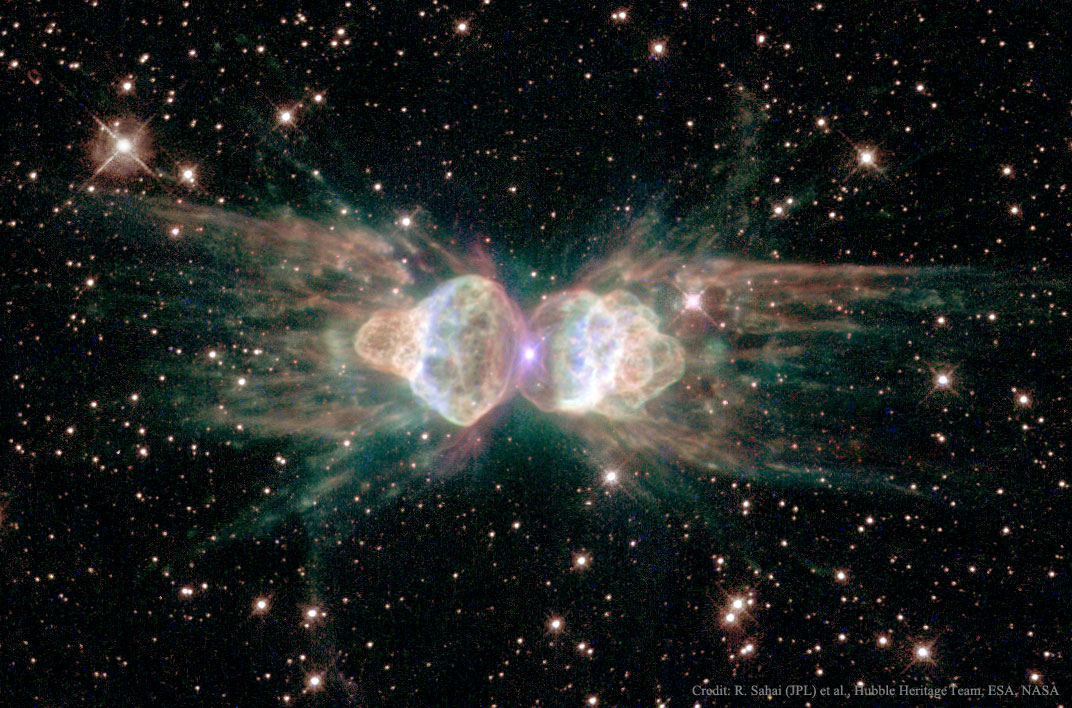25. April 2021
行星形星雲 Mz3:狗蟻星雲

探索宇宙1!逐工會揀一幅無仝款 ê 影像抑是相片,𤆬你熟似咱這个迷人 ê 宇宙,閣有專業天文學者2為你解說3。
- 原始文章:Planetary Nebula Mz3: The Ant Nebula
- 影像來源:R. Sahai (JPL) et al., Hubble Heritage Team, ESA, NASA
- 台文翻譯:An-Li Tsai (NCU)
[漢羅] 行星形星雲 Mz3:狗蟻星雲
這隻狗蟻敢毋是一个大球體? 行星形星雲 Mz3 是一个去予像咱 太陽 仝款 ê 恆星 kā 擲–出去 ê 物質,所以一定是圓–ê。 毋閣,是按怎這个 噴–出去 ê 氣體生做 狗蟻形,毋是圓 ê? 這个線索可能會當 tī 這个去予用一秒鐘 1000 公里緊 ê 速度噴–出去 ê 氣體,這个 光年 長 ê 結構,閣有這个星雲中心 恆星 ê 磁性 內底揣著。 另外一个可能 ê 答案,是 Mz3 閣藏一粒較暗 ê 恆星,踅 較光彼粒 leh 行。 有一个可能性較懸 ê 假設 講,是中心恆星 ê 自旋 kah 磁場 leh 引導氣體。 因為這个中心恆星 敢若 kah 咱 ê 太陽足仝 ê,天文學家 希望會當 閣較了解 這隻大隻太空 狗蟻 ê 歷史。 按呢 to̍h 會當提供有路用 ê 見識,予咱了解咱 ê 太陽 kah 地球 ê 未來。
[POJ] Kiâⁿ-chhiⁿ-hêng seng-hûn Menzel 3: Káu-hiā seng-hûn
Chit-chiah káu-hiā kám m̄-sī chi̍t-ê tōa kiû-thé? Kiâⁿ-chhiⁿ-hêng seng-hûn Mz-saⁿ sī chi̍t-ê khì hō͘ chhiūⁿ lán Thài-iông kāng-khoán ê hêng-chhiⁿ kā tàn–chhut-khì ê bu̍t-chit, só͘-í it-tēng sī îⁿ–ê. M̄-koh, sī án-ná chit-ê phùn–chhut-khì ê khì-thé seng-chò káu-hiā-hêng, m̄-sī îⁿ–ê? Chi̍t-ê sòaⁿ-soh khó-lêng ē-tàng tī chit-ê khì hō͘ iōng chi̍t-bió-cheng chi̍t-chheng kong-lí kín ê sok-tō͘ phùn–chhut-khì ê khì-thé, chit-ê kng-nî tn̂g ê kiat-kò͘, koh-ū chit-ê seng-hûn tiong-sim hêng-chhiⁿ ê chû-sèng lāi-té chhōe-tio̍h. Lēng-gōa chi̍t-ê khó-lêng ê tap-àn, sī Menzel-saⁿ koh chhàng chi̍t-lia̍p khah-àm ê hêng-chhiⁿ, se̍h khah-kng hit-lia̍p leh kiâⁿ. Ū chi̍t-ê khó-lêng-sèng khah-koân ê ká-siat kóng, sī tiong-sim hêng-chhiⁿ chū-soân kah chû-tiûⁿ leh ín-tō khì-thé. In-ūi chit-ê tiong-sim hêng-chhiⁿ ká-ná kah lán ê thài-iông chiok-kâng ê, thian-bûn ha̍k-ka hi-bāng ē-tàng koh-khah liáu-kái chi̍t-chiah tōa-chiah thài-khong káu-hiā ê le̍k-sú. Án-ne to̍h ē-tàng thê-kiong ū-lō͘-iōng ê kiàn-sek, hō͘ lán liáu-kái lán ê Thài-iông kah Tē-kiû ê bī-lâi.
[KIP] Kiânn-tshinn-hîng sing-hûn Menzel 3: Káu-hiā sing-hûn
Tsit-tsiah káu-hiā kám m̄-sī tsi̍t-ê tuā kiû-thé? Kiânn-tshinn-hîng sing-hûn Mz-sann sī tsi̍t-ê khì hōo tshiūnn lán Thài-iông kāng-khuán ê hîng-tshinn kā tàn–tshut-khì ê bu̍t-tsit, sóo-í it-tīng sī înn–ê. M̄-koh, sī án-ná tsit-ê phùn–tshut-khì ê khì-thé sing-tsò káu-hiā-hîng, m̄-sī înn–ê? Tsi̍t-ê suànn-soh khó-lîng ē-tàng tī tsit-ê khì hōo iōng tsi̍t-bió-tsing tsi̍t-tshing kong-lí kín ê sok-tōo phùn–tshut-khì ê khì-thé, tsit-ê kng-nî tn̂g ê kiat-kòo, koh-ū tsit-ê sing-hûn tiong-sim hîng-tshinn ê tsû-sìng lāi-té tshuē-tio̍h. Līng-guā tsi̍t-ê khó-lîng ê tap-àn, sī Menzel-sann koh tshàng tsi̍t-lia̍p khah-àm ê hîng-tshinn, se̍h khah-kng hit-lia̍p leh kiânn. Ū tsi̍t-ê khó-lîng-sìng khah-kuân ê ká-siat kóng, sī tiong-sim hîng-tshinn tsū-suân kah tsû-tiûnn leh ín-tō khì-thé. In-uī tsit-ê tiong-sim hîng-tshinn ká-ná kah lán ê thài-iông tsiok-kâng ê, thian-bûn ha̍k-ka hi-bāng ē-tàng koh-khah liáu-kái tsi̍t-tsiah tuā-tsiah thài-khong káu-hiā ê li̍k-sú. Án-ne to̍h ē-tàng thê-kiong ū-lōo-iōng ê kiàn-sik, hōo lán liáu-kái lán ê Thài-iông kah Tē-kiû ê bī-lâi.
[English] Planetary Nebula Mz3: The Ant Nebula
Why isn’t this ant a big sphere? Planetary nebula Mz3 is being cast off by a star similar to our Sun that is, surely, round. Why then would the gas that is streaming away create an ant-shaped nebula that is distinctly not round? Clues might include the high 1000-kilometer per second speed of the expelled gas, the light-year long length of the structure, and the magnetism of the star featured here at the nebula’s center. One possible answer is that Mz3 is hiding a second, dimmer star that orbits close in to the bright star. A competing hypothesis holdshypothesis holds that the central star’s own spin and magnetic field are channeling the gas. Since the central star appears to be so similar to our own Sun, astronomers hope that increased understanding of the history of this giant space ant can provide useful insight into the likely future of our own Sun and Earth.
詞彙學習(漢羅/POJ/KIP/華語/English)
- 【行星形星雲】kiâⁿ-chhiⁿ-hêng seng-hûn/kiânn-tshinn-hîng sing-hûn/行星狀星雲/planetary nebular
- 【狗蟻星雲】Káu-hiā seng-hûn/Káu-hiā sing-hûn/螞蟻星雲/the Ant Nebula